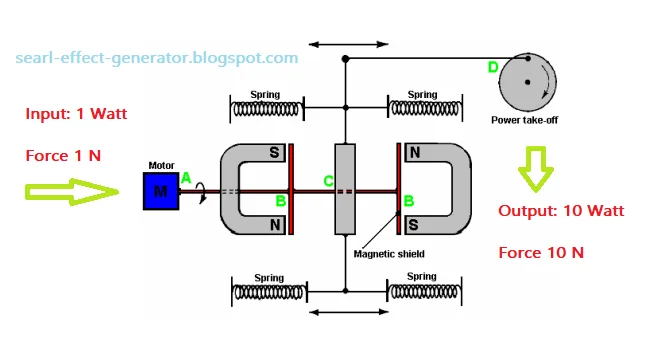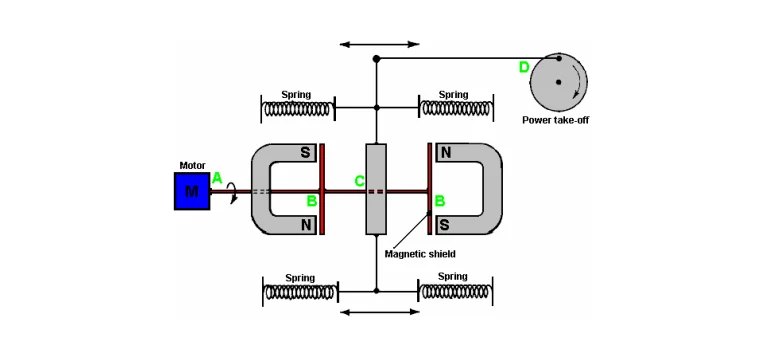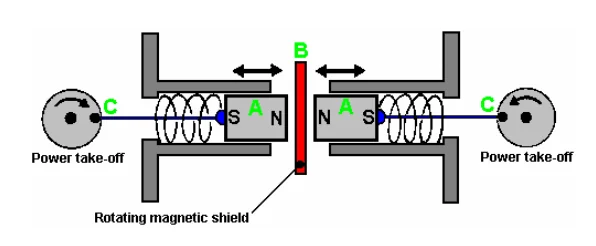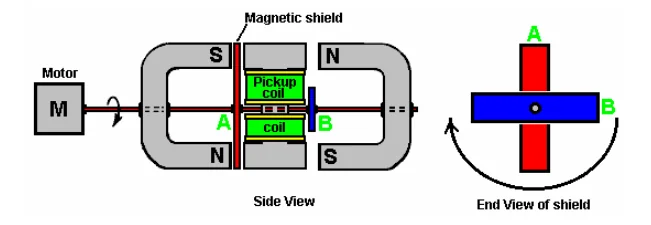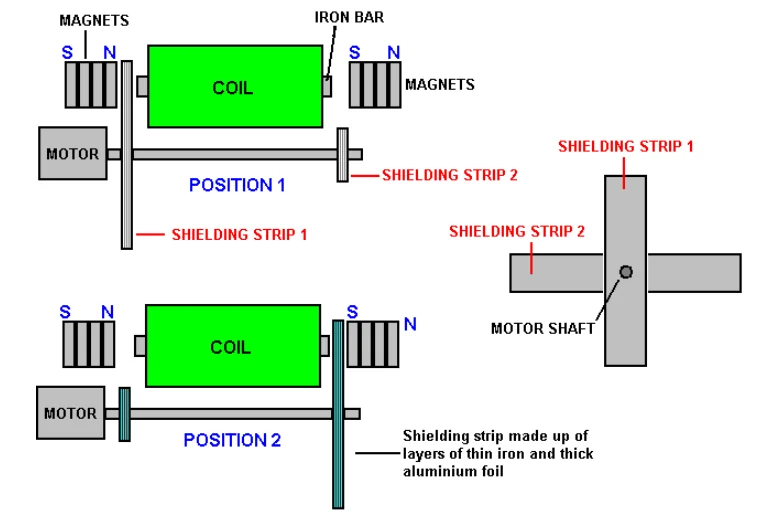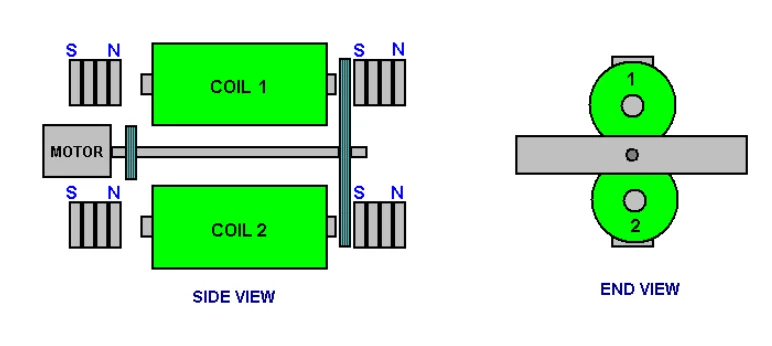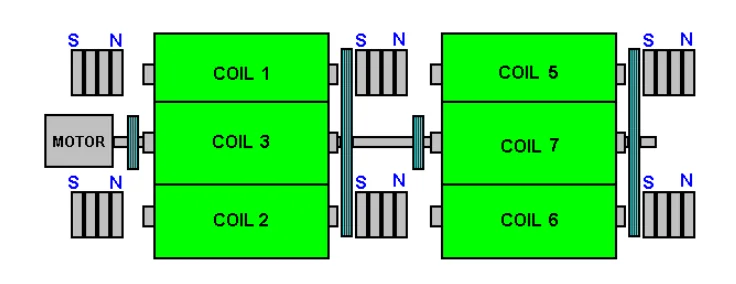John Ecklin’s Magnetic-Shielding Generator
Brief introduction to John W. Ecklin's idea in patent 3,879,622 on March 29th 1974
Magnetic potential energy, a concept often underexplored in traditional energy generation, takes center stage in John W. Ecklin's Magnetic-Shielding Generator. The crux of the innovation lies in harnessing the force of the magnetic field to create a generator with an output power far surpassing the input power. In the first operational style, a low-power motor drives the rotation of a magnetic shield, strategically placed to interfere with the pull of two magnets. This dynamic interplay generates a fluctuating magnetic field, setting in motion a generator drive. The ingenious use of mu-metal strips as shielding elements creates a conductive path for magnetic lines of force, effectively manipulating the magnetic pull at specific points. As the magnetic shield oscillates between shielding and exposing the magnets, a mechanical linkage translates this movement into rotation at the generator drive point. The result is a system where the relatively low effort required to rotate the magnetic shield yields an output that surpasses the input, offering the potential to power the motor driving the entire process.
Brief introduction to John W. Ecklin's idea in patent 3,879,622 on March 29th 1974
Ecklin's patented design, granted in 1974, showcases another dimension of magnetic potential energy utilization. In the second operational style, reciprocating movement is induced through the same shielding concept, and this motion is converted into two rotary motions to drive two generators. In this configuration, two magnets are pressed towards each other by springs, creating potential energy as the springs extend. When an electric motor moves the magnetic shield out of the way, the magnets, now repelled from each other due to their close North poles, compress the springs. The resulting mechanical linkages transfer this reciprocating force into rotary motion, powering two generators. This innovative use of magnetic shielding not only demonstrates an efficient conversion of potential energy into useful work but also showcases the versatility of magnetic fields in energy generation. Ecklin's Magnetic-Shielding Generator represents a paradigm shift in thinking about magnetic potential energy, offering a glimpse into the untapped possibilities within this realm of physics for sustainable energy solutions.
John W. Ecklin was granted US Patent Number 3,879,622 on 29th March 1974. The patent is for a magnet/electric motor generator which produces an output greater than the input necessary to run it. There are two styles of operation. The main illustration for the first is:
Here, the (clever) idea is to use a small low-power motor to rotate a magnetic shield to mask the pull of two magnets. This causes a fluctuating magnet field which is used to rotate a generator drive.
In the diagram above, the motor at point ‘A’ rotates the shaft and shielding strips at point ‘B”. These rectangular mu-metal strips form a very conductive path for the magnetic lines of force when they are lined up with the ends of the magnets and they effectively shut off the magnet pull in the area of point ‘C’. At point ‘C’, the spring-loaded traveller is pulled to the left when the right-hand magnet is shielded and the left hand magnet is not shielded. When the motor shaft rotates further, the traveller is pulled to the right when the left-hand magnet is shielded and the right hand magnet is not shielded. This oscillation is passed by mechanical linkage to point ‘D’ where it is used to rotate a shaft used to power a generator.
As the effort needed to rotate the magnetic shield is relatively low, it is claimed that the output exceeds the input and so can be used to power the motor which rotates the magnetic shield.
The second method for exploiting the idea is shown in the patent as:
Here, the same shielding idea is utilised to produce a reciprocating movement which is then converted to two rotary motions to drive two generators. The pair of magnets ‘A’ are placed in a housing and pressed towards each other by two springs. When the springs are fully extended, they are just clear of the magnetic shield ‘B’. When a small electric motor (not shown in the diagram) moves the magnetic shield out of the way, the two magnets are strongly repelled from each other as their North poles are close together. This compresses the springs and through the linkages at ‘C’ they turn two shafts to generate output power.
A modification of this idea is the Ecklin-Brown Generator. In this arrangement, the movable magnetic shielding arrangement provides a direct electrical output rather than a mechanical movement:
Here, the same motor and rotating magnetic shield arrangement is used, but the magnetic lines of force are blocked from flowing through a central I-piece. This I-piece is made of laminated iron slivers and has a pickup coil or coils wound around it.
The device operates as follows:
In the position shown on the left, the magnetic lines of force flow downwards through the pickup coils. When the motor shaft has rotated a further ninety degrees, the situation on the right occurs and there, the magnetic lines of force flow upwards through the pickup coils. This is shown by the blue arrows in the diagram. This reversal of magnetic flux takes place four times for every rotation of the motor shaft. While the Ecklin-Brown design assumes that an electric motor is used to rotate the mu-metal shield, there does not seem to be any reason why the rotation should not be done with a permanent magnet motor.
Toroidal shapes are clearly important in many devices which pull in additional energy from the environment. However, the Ecklin-Brown generator looks a little complicated for home construction, the principle can be used with a much more simple style of construction where the cores of the output coils are straight bars of suitable material such as ‘soft’ iron or perhaps the more readily available masonry anchors:
shaft - the core of the coil
If using the masonry anchors, be sure to cut the conical end off as it alters the magnetic effect in an undesirable way. Using a hand hacksaw and a vise, cutting the end off is a very easy thing to do and that allows an ordinary helical coil to be wound either directly on the shaft or on a simple bobbin which slides on to the shaft. With any such coil, the voltage produced increases as the number of turns in the coil increases. The maximum current draw depends on the thickness of the wire as the thicker the wire, the greater the current which it can carry without overheating.
1 coil diagram
We can use an ordinary magnet or set of magnets at each end of the straight core to cause a strong magnetic field to flow through the core of our coil. As the motor spins the two screening arms they pass alternately between the magnet at one end of the core and then the magnet at the other end of the core, creating a fluctuating magnetic field passing through the coil. The drawing shows just one output coil, but there could be two coils:
2 coil diagram
Or there could be four coils:
4 coil diagram
The coils can be connected in parallel to increase the output current, or they can be connected in series (in a chain configuration) to increase the output voltage. While the drawings show the shields connected directly to the motor drive shaft (a short length of plastic sleeving from a piece of wire would probably be used to help with alignment of the motor shaft and the shielding axle) there is no reason why the shielding should not be on a separate axle mounted in bearings and driven by a belt and pulley wheel arrangement.
With a separate shielding axle, allows a long, stiff axle to be used and that allows there to be additional coils and magnets. The result could be like this:
Optimized with 8 coils
- 🔹 Radiant energy
- 🔹 AC generator - Free Energy
🔹 Tesla Technology and "Free Energy" in practical application
